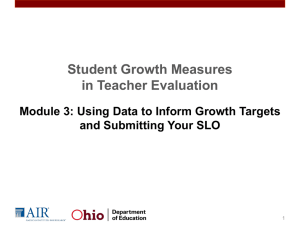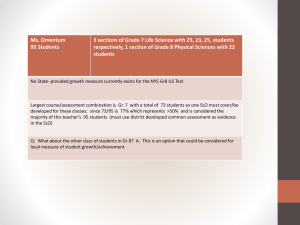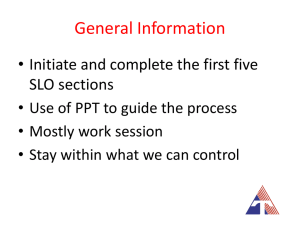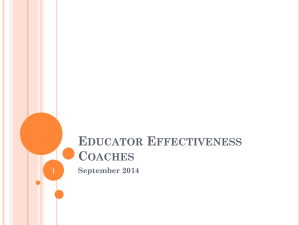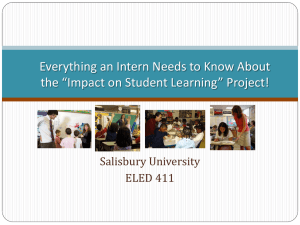SLO Turnkey - Department of Assessment, Research & Evaluation
advertisement
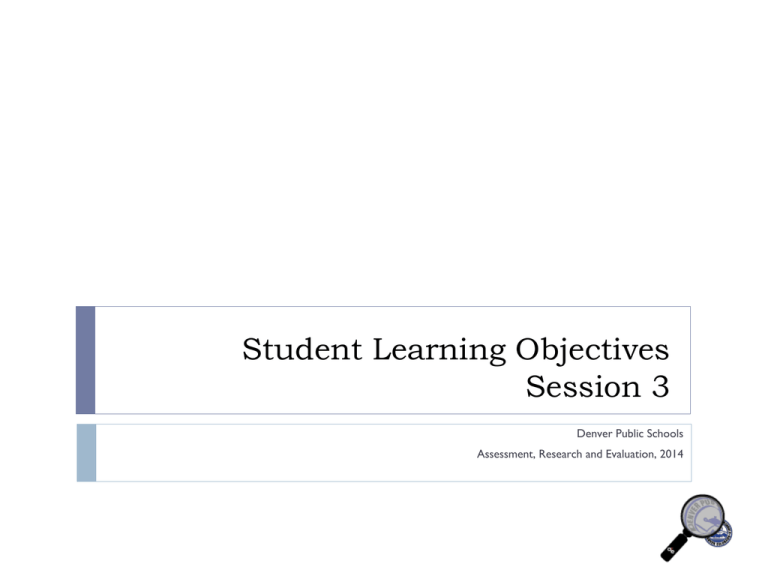
Student Learning Objectives Session 3 Denver Public Schools Assessment, Research and Evaluation, 2014 Objectives Learn how to determine and collect data sources for Baseline Data Learn how to identify each student’s Baseline Preparedness Level Learn how to plan for and collect a Body of Evidence (BOE) Consider how to effectively track data for the BOE Review: What is the Student Learning Objectives (SLO) Process? An improved process for DPS educators to set ambitious learning goals for students and measure their progress toward attaining them Core elements of an SLO: 1. Determine what is most important for students to learn by the end of the year and 2. Measure student progress toward that goal throughout the year. 3. Adjust instruction according to measurements of student progress. The SLO Process Step 1: Create an Objective Statement Step 3: Collect Baseline Data & Categorize Preparedness Levels Step 4: Plan and collect Body of Evidence Step 5: Evaluate and reflect on Student Growth Ongoing Data Driven Instruction Step 2: Determine Performance Criteria & Rubric Collect Baseline Data How prepared are my students to learn the content and language in my Objective? Baseline Data are sources of data with items and/or tasks that indicate students’ levels of preparedness as they relate to the Objective Statement (think prerequisite skills/standards). These data points should be designed/selected collaboratively and scored using a common scoring rubric, if possible. Baseline Data Sources Remember: Include at least two different sources of Baseline Data for each Objective. E.g. previous year’s EOY Interim, TCAP, current performance in the SLO content area Include ACCESS scores or other language information, if applicable. Possible Baseline Data sources may include: SCAN assessments, Anet assessments, STAR, DRA2, EDL2, SRI, TCAP, CMAS, ACCESS, ABCC, CoAlt, TS Gold, Course Finals, End of Year interims, teacher made assessments, common assessments Baseline Preparedness How might I categorize my students to set appropriate learning goals and track student growth from the Baseline? Students are categorized based on their preparedness levels as they relate to the Objective Statement. Baseline Preparedness categories provide a reference point of students’ knowledge and skills at the beginning of the course so as to determine progress throughout the course. Please note: Baseline preparedness categories are NOT the same as instructional groups Categorize Preparedness Levels Using information from Baseline Data Sources, students should be categorized based on the following Preparedness Levels: Underprepared: Students who enter the course/grade one or more course/grade levels behind in the prerequisite standards. Somewhat Prepared: Students who enter the course/grade less than one year behind in the prerequisite standards. Prepared: Students who enter the course/grade with command of the prerequisite standards. Ahead: Students who enter the course/grade with a deep command of the prerequisite standards. These students are able to apply previous learning to a variety of contexts. Plan for and Collect a Body of Evidence How are my students progressing in their mastery of the content and language in my Objective? The Body of Evidence is data derived from a variety of assessment tools that measure the degree to which students are progressing toward each Performance Criterion and more broadly the Objective Statement The information gathered should be used to adjust instruction appropriately in order to maximize student growth. Body of Evidence Guidelines For each Performance Criterion, there should be: Multiple items and tasks that are aligned in content and differentiated appropriately. Well-designed, rigorous tasks may address multiple Performance Criteria. Each task should provide teachers information on student progress in order to indicate and then confirm students’ end of course proficiency levels. Items and tasks for the BOE should be designed/selected collaboratively and scored using a common scoring guide/rubric. Possible Pieces for Body of Evidence Information included in a Body of Evidence may vary widely depending on the teacher role, Objective Statement and Performance Criteria, and students. Possible data sources include but are not limited to: District assessments (including interims/course assessments/SCAN/Anet), assessments and tasks from the curriculum, (including tests, quizzes, homework), performances, teacher observations, vendor assessments (e.g. DRA, STAR, SMI, MAP, etc.), language assessments, projects No matter what data sources are used, teachers should think critically about the quality of the data first. Body of Evidence Guiding Questions How do we ensure that the data in the BOE gives us highquality information about student growth? Teacher teams will need to ask critical questions of each piece of evidence. Questions may include: How well does this assessment measure the standards that are addressed in my Objective? How well does this assessment measure those standards at the appropriate level of rigor? For what purpose was this assessment designed? To what extent does it match my purpose? If two different people were to assess the same student with this assessment, would they come up with the same estimate of student proficiency? A detailed Guiding Questions document can be found online at the SLO webpage. Data Tracking Teacher teams and school leaders will want to agree upon a method for tracking student progress on the Body of Evidence. There is not one correct way to track data for the SLO Process, rather it is important that teachers find a method that works for them and their school leaders. Electronic data trackers, such as Excel spreadsheets or those kept in Google will allow teams to share data with one another and their school leaders, similar to the Google SLO Planning Pages. Purposeful sampling of student work should also be considered – it is important that teachers check with their school leaders to see what student work the leader may want to see at their end of year conversation. School Leaders Teachers SLO Timeline 2014-15 *Gain familiarity with the SLO process Aug Present SLO overview to teachers *Create 2 Objective Statements Sept *Determine Performance Criteria and Rubric *Collect Baseline Data *Submit Phase 1 using SLO application Oct Ensure access to SLO Application *Analyze Baseline Data and categorize students’ Baseline Preparedness Levels Nov Approve Phase 1 *Plan and Collect Body of Evidence, monitor progress, and adjust instruction accordingly Dec *Collect Body of Evidence, monitor progress, and adjust instruction accordingly *Submit Phase 2 using SLO application Jan *Collect Body of Evidence, monitor progress, and adjust instruction accordingly Feb *Collect Body of Evidence, monitor progress, and adjust instruction accordingly Mar *Collect Body of Evidence, monitor progress, and adjust instruction accordingly Apr Approve Phase 2 Ongoing Data Team Guidance and Support Please note: For classroom teachers, Phase 1 information includes the Objective Statement and Performance Criteria; Phase 2 information includes the Rubric, Baseline Data, Baseline Preparedness Levels, and the plan for Body of Evidence; and Phase 3 information includes the students’ end of course proficiency levels. *Evaluate and reflect on student growth *Submit Phase 3 using SLO Application May Submit ratings Questions? http://testing.dpsk12.org/resources/SLO.html Email: slohelp@dpsk12.org
